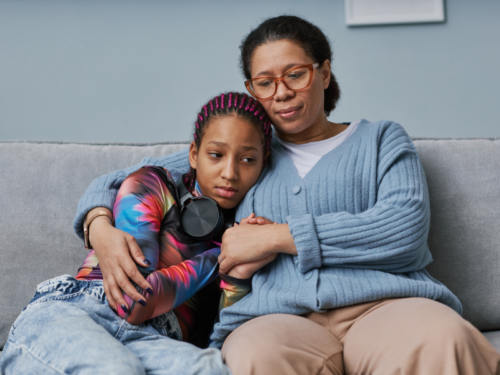
Table of Contents
Addressing Boys’ Mental Health

Written By: Brian Mastroianni

Clinically Reviewed By: Dr. Don Gasparini
Updated: May 31, 2024
11 min.
Boys' mental health is often overlooked in conversations around the youth mental health crisis. Here's why that needs to change.
Learn more about our Clinical Review Process
Table of Contents
We are living in the middle of a global mental health crisis, and one group that is particularly underserved and under-examined is men and boys. Although boys and men report symptoms of mental health conditions at similar rates to girls and women, societal stigma and gender norms often keep male mental health issues out of the spotlight.
Today, there is a clear gender gap between boys and girls in terms of who is more likely to reach out for mental health support. Teen girls are three times more likely to report depression symptoms than their male peers, according to the Pew Research Center. Compare that to the fact that one-third of boys report they feel society expects them to “hide or suppress their feelings when they feel sad or scared.”
Below, we delve into what you need to know about addressing male teen mental health, including common causes and symptoms for male teen mental health issues and support systems that are out there. We also explore how to break down the barriers that prevent mental health from being a front-and-center concern for people of all genders — since boys’ and men’s mental health matters.

Virtual mental health support for boys and young men
We connect boys and young men with therapists who understand their needs and peer groups from similar backgrounds.
How do men and boys deal with mental health?
Young men fare worse compared to their female teen peers when being evaluated for mental health issues like suicide and substance use disorders, among others.
According to a 2018 review in the Journal of Adolescent Health, teen and young adult men have a distinct “health risk profile” from young women and girls, which means their intervention needs are different. The authors write that teen boys tend to disconnect from health care services, which sets off a domino effect throughout their lives as they grow up, leading to a lack of engagement with therapy and a “self-stigma” that might prevent them from readily seeking the support they need.
Estimates show that just 13.2% of young men who range from 16 to 24 years old will access mental health services if they experience signs of mental illness or a related issue. While the gap between teen boys and girls seeking mental health services is a clear problem globally, this disparity often stands unaddressed throughout the world.
What are common mental health symptoms that teen boys face?
In a 2019 article, board-certified behavior analyst Diana Cortese points to the ways our society conditions everyone — from providers and parents to young men themselves — to not readily spot signs and symptoms of mental illness like depression in men and boys.
“As boys grow up, their outward expression of emotions starts to narrow along with their vocabulary to label, identify, and express what they are feeling,” Cortese writes. “Although no one outwardly says, ‘don’t express yourself,’ the lack of reinforcement for doing so leads to most boys intrinsically feeling like they should deal with things by themselves.”
If a boy is experiencing signs of depression, like hopelessness or sadness, for example, he might respond to these feelings with anger. He may lash out in an aggressive way, and the adults in his life might not pick up on what is going on with his mental health in the same way they may be conditioned to be attuned to the needs of the young girls in their lives. This lack of familiarity with the nuances of adolescent male mental health can result in common signs of mental illness worsening or remaining untreated.
Some common mental health symptoms experienced by young men include:
- Substance abuse
- Violence and aggressive behavior
- Difficulty focusing and expressions of restlessness
- Weight fluctuations
- Shifts in appetite
- Risky behaviors
- Tiredness
- Neurotic behaviors like obsessive thinking
- Socially withdraw from friends and family
What are some common mental health conditions for male teens?
Suicide is one of the most pressing mental health concerns affecting teen boys. A 2019 review sheds light on gender differences in young adult suicide trends. It shows suicide rates in teen boys are 2-to-4 times higher than they are for their female peers.
One of the biggest flaws in our society’s focus on suicide in young men stems from the fact that the suicide or suicide attempt itself is often the sole statistic reported on versus the many factors leading up to it. Essentially, in our society, we often fail to address the underlying issues that contribute to poor mental health in adolescent boys. Here’s a look at five of the most common mental health disorders seen in men and boys:
Depression
While teen girls are more likely to have reported experiencing depression, 7% of teen boys reported having at least one major depressive episode in the past 12 months, according to 2017 statistics cited by the Pew Research Center. What’s more, the treatment inequality gap for teen depression between boys and girls is clear: the same statistics show just 33% of teen boys received treatment for depression over the past year compared to 45% of girls.
Anxiety
The National Institute of Mental Health reports an estimated 31.9% of adolescents in the United States overall have an anxiety disorder of some kind. Within this population, 26.1% of teen males have an anxiety disorder. This could include conditions like obsessive-compulsive disorder (OCD), social anxiety disorder (SAD), and panic disorder, among others.
Substance use disorders
Countless studies show that young adolescent men are more likely than their female peers to abuse drugs and illicit substances, which can include prescription painkillers, marijuana, and hallucinogens. Statistics show that 11.5% of boys and young men over the age of 12 have a substance use disorder, compared to 6.4% of girls and young women.
Post-traumatic stress disorder (PTSD)
Overall, 60% of men will experience at least one traumatic event in their lives. This can be related to witnessing a death or injury, surviving a sexual assault, or living through an accident, among other factors. In many cases, these traumas stem from childhood and adolescent years. Studies show anywhere from 14%-43% of boys will go through at least one trauma in their young lives. Out of that number, 1%-6% of boys will ultimately develop PTSD.
Bipolar disorder
Bipolar disorder symptoms, marked by severe shifts in up-and-down moods, have been evidenced in 2.6% of young men from 13 to 18 years old in the United States, according to data from the National Institute of Mental Health. As with other mental health issues, there appears to be a gender gap in our broader understanding of how it shows up in young people. Sometimes, this condition goes under the radar in teen boys because some of the symptoms (think reckless behavior or expressions of overconfidence) are often stereotyped as “traditional male behavior” rather than symptoms of a mental illness.
What is male mental health stigma?
One of the big issues that contribute to negative mental health outcomes for men and boys is stigma. In her 2019 article, behavior analyst Diana Cortese outlines the “social-emotional double standard” when it comes to addressing mental health concerns for girls and boys. Girls are openly encouraged and supported in discussing their feelings and that it is normal to show their emotions, but Cortese adds that boys are encouraged to be “dominant’ and “emotionally stoic.”
This toxic cultural dynamic means adolescent boys are less likely to open up with friends, teachers, parents, and mental health professionals about depressive symptoms, for example. By not being conditioned to be open about these issues, young men don’t have the vocabulary to recognize and discuss what is going on and ultimately seek what could be life-saving mental health services.
In many ways, stigma is a lifelong battle that boys face, beginning even in their earliest years of childhood. Why don’t men open up about their mental health? Our society often penalizes men for straying from gender norms. Disclosing vulnerability and outwardly seeking help can make men appear to have a lower status in our society at large. Men who express an emotion as fundamental to the human experience, such as sadness, are often viewed as being “less deserving” of having that feeling than women. Research has shown that men who cry at work are thought to be “less competent” than their female counterparts who cry at their desks.
Stigma also exists for adult men who take on less traditional gender roles, from male nurses to stay-at-home dads. This can affect a person’s sense of self-worth and belonging in the world. One of the more insidious stigmas attached to perceived masculine norms in our society relates to men and boys who are victims of sexual assault. One in 53 boys under the age of 18 experience sexual violence or assault from an adult, which can bring with it a string of negative mental health outcomes and symptoms, and survivors of sexual assault are 10 times more likely to commit suicide than those who have never experienced this kind of assault.
Narrowing that down further, one 2014 study surveyed students between 14 and 18 years old to see whether sexual assault and struggles with body weight influenced suicide attempts within a year of the survey painted a stark picture for adolescent boys who are the victims of sexual assault. The researchers found 33.2 percent of healthy-weight male survey participants with a sexual assault history attempted suicide. “This can be attributed to stigma, shame, possible gender role conflict if the attacker was male, and the lack of an open support system,” according to a 2015 Futurity article about the study.
While common — one in 33 men report experiencing either an attempted or completed rape in the course of their life, according to the Rape, Abuse, and Incest National Network (RAINN) — the reality of sexual abuse among adult men and adolescent boys pushes against the wall of cultural stigma that makes any issue involving male mental health something that can’t be discussed, or that needs to be swept under the rug.
The reality of mental health inequalities for young men
The global mental health problem for young men and boys is a public health issue. It can reach wide, impacting large swaths of society.
Culturally, girls’ mental health is typically prioritized over boys’ mental health, which is yet another inequitable barrier to care. In many cases, the early onset of mental health issues for male children and teen boys can result in a range of issues impacting a man’s quality of life years later, leading them to the burden of a lifetime of negative symptoms. This can mean lower incomes earned and social adjustment. Elevated suicide risk and increased violence and aggression toward others in a man’s adult years can stem from the mental health struggles he had as a young boy. By not tackling these poor mental health issues head-on for a young man can entrench gender disparities in whose mental health is being treated most effectively.
Within the macro problem of the gender gap in mental health care is the pressing reality of systemic health inequalities that see gaps in care between white male adolescents and young men of color. The COVID-19 pandemic itself further widened these gaps in how a mental health disorder is addressed between those with more social support and resources and those who are from more vulnerable communities.
Discrimination and systemic barriers for African American and Black communities in the U.S. and around the world, respectively, mean that a young white man seeking care — while still facing the stigma that exists for male mental health — will have more resources readily available than his peers of color. A white young man might be more readily admitted to a healthcare facility to treat his mental health symptoms, for example.
In one stark illustration of this, a 2020 study in The Lancet on the state of mental health in the United Kingdom before and after the onset of the pandemic showed recovery rates after psychological therapies were higher for white British people compared to those of all other ethnic groups. A 2022 report from Communities United on the mental health and well-being of Black and brown men in Chicago revealed young men of color view a “deep connection between systemic inequities and mental health,” with many not feeling the systems in place for support and intervention are “built to support them.” In the survey, 66% reported experiencing challenges with their mental health.

Exploring the causes of teenage depression in boys
As with any mental health condition, there is no “one size fits all” cause for depression among teen boys and young men. Myriad factors can play a role. Let’s explore the causes of teenage depression in boys with some examples:
- The COVID-19 pandemic forced life to come to a crashing halt for many young men, disrupting their normal social and school lives, relationships with peers, and sense of normalcy and stability.
- A young man might be prone to drinking a lot or using illicit substances.
- A family member — such as a parent — might also experience signs and symptoms of depression or be diagnosed with a mental illness.
- He might have experienced a recent injury or is recovering from a serious medical condition.
- A young adolescent male might have a personality that is easily susceptible to developing depressive symptoms, such as an obsessive personality or having the tendency to worry about things a lot.
- A young man might regularly suffer from seasonal affective disorder (SAD).
- A teen boy might be facing difficulties at school with academics or extracurricular activities.
- He might be the victim of sexual violence or sexual assault.
Interpersonal therapy, or interpersonal psychotherapy for adolescents (IPT-A), might be an effective way for an adolescent boy to address his mental health concerns. This technique, which is offered by Charlie Health, involves time-limited individualized psychotherapy for adolescents between 12 and 18 years old who are experiencing depression. A therapy approach that is tailor-made for a young man’s individual needs and that touches on his specific experiences might be the best way to engage with a mental health issue as specific and varied as depression.
10 signs of mental health issues in teen boys
- Frequent mood swings or irritability
- Difficulty managing emotions or expressing feelings
- Changes in sleep patterns, such as difficulty falling or staying asleep or sleeping too much
- Loss of interest in activities or hobbies they used to enjoy
- Isolation or withdrawal from friends and family
- Decreased academic performance or disinterest in school
For example, boys are more likely than girls to be diagnosed with ADHD, which can affect their ability to focus, organize, and regulate their behavior. - Frequent headaches or stomach aches with no physical explanation
- Engaging in risky behaviors, such as substance use or unprotected sex.
Boys are more likely than girls to use drugs and alcohol. - Displaying aggressive or violent behavior
Specifically, boys are also more likely to be diagnosed with conduct disorder, which involves persistent patterns of behavior that violate the rights of others or social norms. - Persistent feelings of sadness, hopelessness, or worthlessness
While girls are more likely to be diagnosed with depression, boys are more likely to die by suicide.
How Charlie Health can help teen boys with mental health issues
If a boy or young man in your life is struggling with family trauma, Charlie Health is here to help. Charlie Health’s virtual Intensive Outpatient Program (IOP) provides more than once-weekly mental health treatment for young people and families dealing with serious mental health conditions Our expert clinicians incorporate evidence-based therapies into individual counseling, family therapy, and group sessions. We also match people with peers who share similar life experiences and conditions to promote empathy and long-term healing. With this kind of holistic treatment, managing mental health issues is possible. Fill out the form below or give us a call to start healing today.




